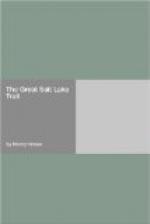Immediately after Captain Ten Eyck moved out, and by orders of Colonel Carrington issued at the same time as the orders detailing that officer to join Colonel Fetterman, the quartermaster’s employees, convalescents, and all others in the garrison, were armed and provided with ammunition, and held in readiness to re-enforce the troops fighting, or defend the garrison.
Captain Ten Eyck reported, as soon as he reached a summit commanding a view of the battle-field, that the Peno Valley was full of Indians; that he could see nothing of Colonel Fetterman’s party, and requested that a howitzer should be sent him. The howitzer was not sent. The Indians, who at first beckoned him to come down, now commenced retreating, and Captain Ten Eyck, advancing to a point where the Indians had been standing in a circle, found the dead naked bodies of Brevet Lieutenant-Colonel Fetterman, Captain Brown, and about sixty-five of the soldiers of their command. At this point there were no indications of a severe struggle. All the bodies lay in a space not exceeding thirty-five feet in diameter. No empty cartridge shells were lying about, and there were some full cartridges. A few American horses lay dead a short distance off, all with their heads toward the fort. This spot was by the roadside, and beyond the summit of the hill rising to the east of Peno Creek. The road, after rising this hill, follows this ridge along for about half or three-quarters of a mile, and then descends abruptly to Peno Creek. At about half the distance from where these bodies lay to the point where the road commences to descend to Peno Creek was the dead body of Lieutenant Grummond; and still farther on, at the point where the road commences to descend to Peno Creek, were the dead bodies of the three citizens and four or five of the old, long-tried, and experienced soldiers. A great number of empty cartridge shells were on the ground at this point, and more than fifty lying on the ground about one of the dead citizens, who used a Henry rifle. Within a few hundred yards in front of this position ten Indian ponies lay dead, and there were sixty-five pools of dark and clotted blood. No Indian ponies or pools of blood were found at any other point. Our conclusion, therefore, is that the Indians were massed to resist Colonel Fetterman’s advance along Peno Creek on both sides of the road; that Colonel Fetterman formed his advanced lines on the summit of the hill overlooking the creek and valley, with a reserve near where the large number of dead bodies lay; that the Indians, in force of from fifteen to eighteen hundred warriors, attacked him vigorously in this position, and were successfully resisted by him for half an hour or more; that the command then being short of ammunition, and seized with panic at this event and the great numerical superiority of the Indians, attempted to retreat toward the fort; that the mountaineers and old soldiers, who had learned




